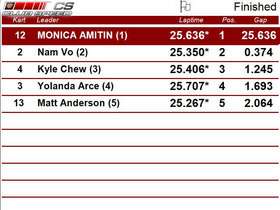Los Angeles, CA – Oskar Systems, LLC has a registered copyright in a software program that is designed to operate every aspect of a go-kart racing business. The registration certificate is attached as Exhibit D to its complaint (copy of the complaint is available here). The software is adapted for a wide range of functions, from record keeping all the way to individual driver timing and statistical analysis. The software is licensed to several customers, on an annual basis, and Plaintiff charges an annual fee for maintaining the software system.
 In 2005, Oskar alleges that it licensed the software to Pole Position Raceway, Inc., an indoor go-kart racing business located in Corona, California. Pole Position terminated its use of the software two years later. Then, Oskar learned that Pole Position switched to “Speed Sheet” software produced by co-defendant Club Speed, Inc., which is alleged to perform almost exactly the same way that Oskar’s software does, “producing almost identical graphs and reports.” Also, the customer liability waiver agreement is alleged to be identical. A screen capture of Club Speed’s software display, which is at issue in the lawsuit and was obtained from its website, is presented herein.
In 2005, Oskar alleges that it licensed the software to Pole Position Raceway, Inc., an indoor go-kart racing business located in Corona, California. Pole Position terminated its use of the software two years later. Then, Oskar learned that Pole Position switched to “Speed Sheet” software produced by co-defendant Club Speed, Inc., which is alleged to perform almost exactly the same way that Oskar’s software does, “producing almost identical graphs and reports.” Also, the customer liability waiver agreement is alleged to be identical. A screen capture of Club Speed’s software display, which is at issue in the lawsuit and was obtained from its website, is presented herein.
Plaintiff alleges that Club Speed and Pole Position, and their respective principals, have been aggressively marketing the Speed Sheet software and have successfully lured away Plaintiff’s existing customers. The case is Oskar Systems, LLC v. Club Speed, Inc. et al., CV 09-03854 AHM (C.D. Cal. 2009).
PRACTICE NOTE: To establish copyright infringement, Oskar must prove (1) ownership of a valid copyright and (2) unauthorized copying of protected elements of the copyrighted work. See Rice v. Fox Broadcasting Co., 330 F.3d 1170, 1174 (9th Cir. 2003). “Infringement is shown by a substantial similarity of protectible [sic] expression, not just an overall similarity between the works.” 4 Nimmer on Copyright § 13.03[F]. To establish infringement, Oskar must “show[] that the works in question ‘are substantially similar in their protected elements.'” Metcalf v. Bochco, 294 F.3d 1069, 1072 (9th. Cir. 2002).
“It is settled that computer programs are entitled to copyright protection.” General Universal Systems, Inc. v. Lee, 379 F.3d 131, 142 (5th Cir. 2004). “A computer program is made up of several different components, including the source and object code, the structure, sequence and/or organization of the program, the user interface, and the function, or purpose, of the program. Whether a particular component of a program is protected by a copyright depends on whether it qualifies as an ‘expression’ of an idea, rather than the idea itself.” Johnson Controls, Inc. v. Phoenix Control Systems, Inc., 886 F.2d 1173, 1175 (9th Cir. 1989). “[Copyright] protection extends not only to the ‘literal’ elements of computer software — the source code and object code — but also to a program’s nonliteral elements, including its structure, sequence, organization, user interface, screen displays, and menu structures.” Importantly, “[t]he ‘non-literal components’ of a computer program, including its user interface, are protectable if, ‘on the particular facts of each case, the component in question qualifies as an expression of an idea [not] an idea itself.'” Apple Computer v. Microsoft Corporation, 799 F.Supp. 1006, 1020 (N.D. Cal. 1992) (quotation omitted)). Thus, Oskar must prove that the reports are copyrightable and defendants have copied protectable elements of its copyrighted software.
“Copyrighted software ordinarily contains both copyrighted and unprotected or functional elements.” Sony Computer Entertainment, Inc. v. Connectix Corp., 203 F.3d 596, 599 (9th Cir. 2000). Compilations of individually unprotectable elements, however, may be afforded copyright protection: the “collection and assembling of preexisting materials or of data that are selected, coordinated, or arranged in a way that the resulting work as a whole constitutes an original work of authorship.” 17 U.S.C. § 101. Thus, “even if the constituent elements of a work are not protected, protection may extend to the ‘selection, coordination, or arrangement’ of such elements in the work as a whole.” O.P. Solutions, 1999 U.S. Dist. LEXIS 979 at *9; Metcalf, 294 F.3d at 1074 (“[A] particular sequence in which an author strings a significant number of unprotectable elements can itself be a protectable element. Each note in a scale, for example, is not protectable, but a pattern of notes in a tune may earn copyright protection.”).
As for computer software, “if constituent elements of a screen display or user interface lack requisite originality, or are outside the scope of copyrightable material under 102(b), or are otherwise unprotectable, the selection, coordination, and arrangement of such elements may be protectable, even though those individual elements are not.” O.P. Solutions, 1999 U.S. Dist. LEXIS 979 at *9 (citing Apple, 799 F.Supp. at 1023). More importantly, however, “a combination of unprotectable elements is eligible for copyright protection only if those elements are numerous enough and their selection and arrangement original enough that their combination constitutes an original work of authorship.” Satava v. Lowry, 323 F.3d 805, 811 (9th Cir. 2003) (citing Feist, 499 U.S. at 358 (“[T]he principle focus should be on whether the selection, coordination, and arrangement are sufficiently original to merit protection.”)).
 Los Angeles Intellectual Property Trademark Attorney Blog
Los Angeles Intellectual Property Trademark Attorney Blog

